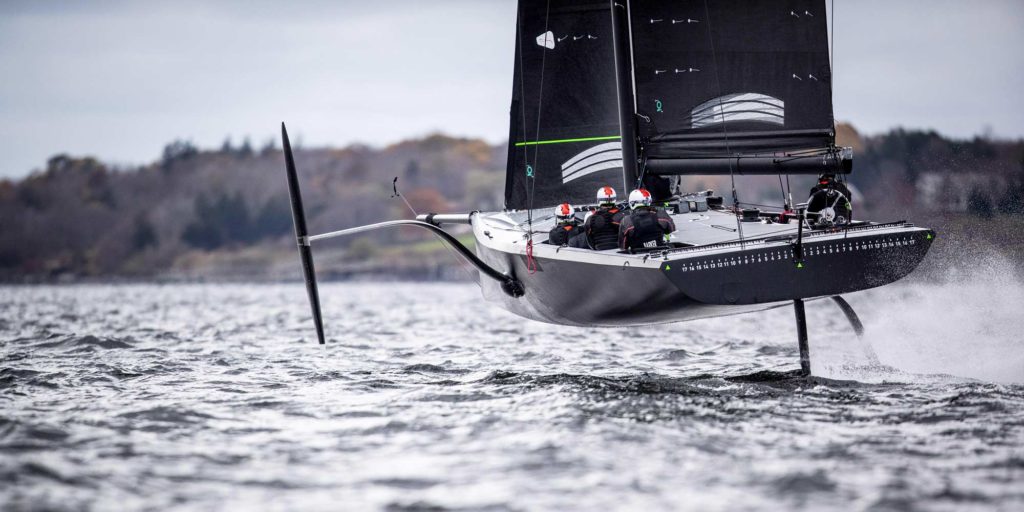
In late October of 2018, under the cover of darkness, American Magic’s builders and shore team rolled their 38-foot test boat out the doorway of its discreet build facility in Bristol, Rhode Island, for an overnight truck delivery across the bay to its temporary base of operations. Soon after stepping the rig and launching, they began methodically learning to efficiently fly a large monohull for the first time, a task that took only handful of days on the water.
Dubbed the “Mule” by the New York YC’s America’s Cup Challenge, the black craft is a modified McConaghy 38 One-Design, albeit one with most of its internal structure stripped out in order to accommodate the closely guarded battery-powered foil and sail-control systems that allow it take off in only 9 knots of wind. According to the first video released by the team at the conclusion of its initial sailing trials, the MC38’s deck was also removed, replaced with a new one that features multiple cockpits and noticeable structure to support a raised self-tacking jib track and the ball joint of its rotating mast-wing section.
(Note: According to Wikipedia: A development mule (test mule, or simply mule) in the automotive industry is a testbed vehicle equipped with prototype components requiring evaluation. They are often camouflaged to deceive competitors and thwart a curious automotive press.)
The Mule’s outboard cockpits feature structural benches for the sailors to sit, putting their weight outboard and low for better aerodynamics. Colored buttons are visible the inside cockpit walls. These, along with handheld units, allow the sailors to make rapid adjustments to foil and sail controls. There are two individual aft cockpits for helmsman Dean Barker, who steers from a pair of small silver wheels he salvaged from Softbank Team Japan’s AC50. Seated in his swiveling go-cart style seat, Barker has his own control buttons and grip adjustments at hand as well as a clear view of the horizon that allows him to scan for changes in wind strength, as well as the lobster pots that dot Rhode Island’s Narragansett Bay. Hooking one of the Mule’s foils while flying at 30 knots is a major concern, says Barker.
The D-section carbon mast visible on the test boat is robust, and while seemingly short in height, its chord length is substantial as is the amount of sail area in play. As allowed by AC75 class rules, Individual mainsail tracks either side of the mast’s aft face hint of a double-surface mainsail concept, all of which is in very early stages of development.
With the sailing team setting up shop in Rhode Island, many of the sailors and their families now have residences in the City by the Sea in order to meet the in-country nationality requirements, including Barker and Olympic medalist and Moth World champion Paul Goodison, of Great Britain, who sits one position forward of Barker on the Mule, managing the mainsail profile. For the early November training sessions, Goodison was flanked by New Zealander Sean Clarkson, Argentinian Maciel Cicchetti, and team CEO, Terry Hutchinson at times. Riding solo in the leeward cockpit was tactician Andrew Campbell, of San Diego, who reportedly takes control of boat during maneuvers while Barker transits between cockpits, a role Campbell is familiar with from his time with Oracle Racing in Bermuda.
RELATED: America’s Cup Challenger Takes Off With Airbus
Initial sailing sessions were productive, says Barker, particularly with regard to validating a few concepts that will be applied to the team’s first AC75 (“Boat 1”), currently under construction in Bristol. “One thing we’ve learned is that the bay is quite small,” said Barker at late October function announcing the team’s partnership with apparel supplier, Helly Hansen. “With the new boat, it will get even smaller.”
Amateur Instagram video showing the American Magic squad on its Mule in early November confirmed the chatter in Newport’s sailing circles that the team didn’t take long at all to achieve liftoff and stable flight, a testament to the talent at hand. As daylight hours grew shorter and the first New England fall cold front swept through the boatyard, sailors and shore team alike made efficient use of their limited days on the water before concluding the first training session on November 11. The Mule will be packed for transit to a warmer Florida venue where testing will soon resume as they await the launch of Boat 1 in late April or May 2019, a date dependent upon the arrival of supplied parts from overseas.









